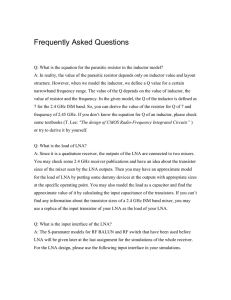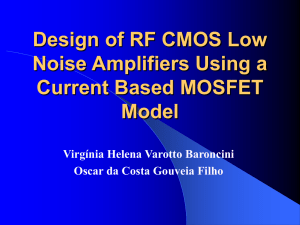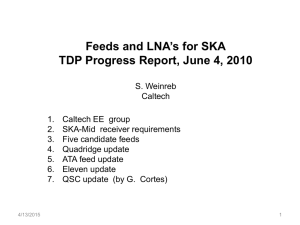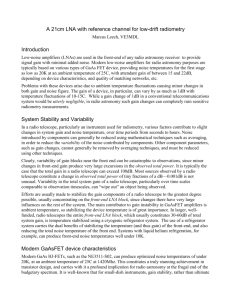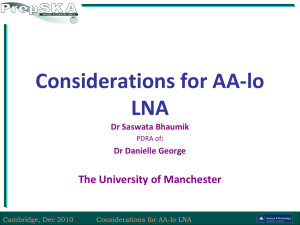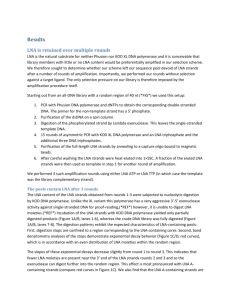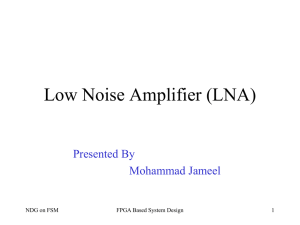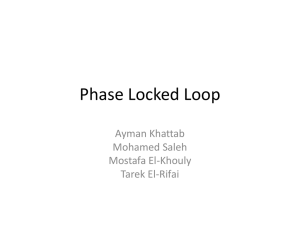MMIC in Radio Astronomy: From Chips to System
advertisement
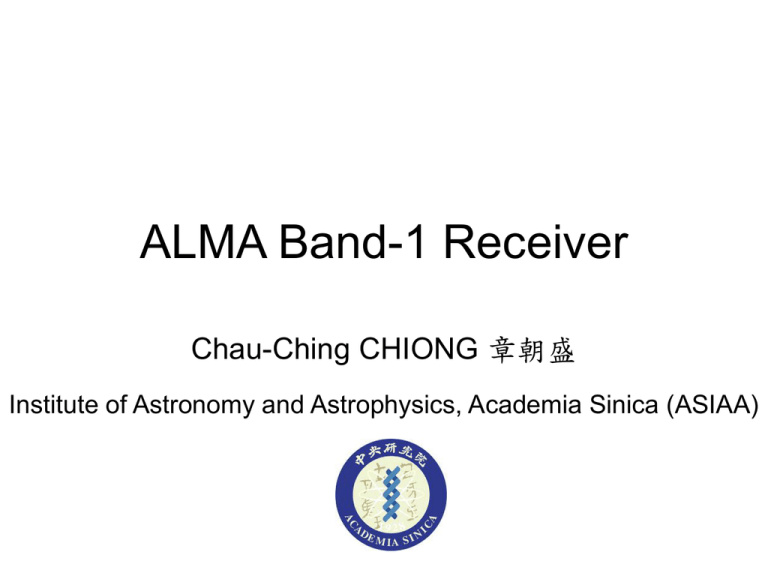
ALMA Band-1 Receiver Chau-Ching CHIONG 章朝盛 Institute of Astronomy and Astrophysics, Academia Sinica (ASIAA) Contributions from … • ASIAA – Microwave Group: Dr. Y.-J. Hwang, Dr. Y.-F. Kuo, Dr. C.-C. Lin, C.-C. Chuang, C.-T. Ho. – Receiver Group: Dr. M.-T. Chen, T.-S. Wei. • National Taiwan University EE – Prof. H. Wang: Dr. Z.-M. Tsai, Dr. B.-J. Huang, W.-J. Tzeng, Y.-C. Wu, B.-H. Tsai, C.-C. Hung. • National Central University EE – Prof. H.-Y. Chang: S.-H. Weng. – Prof. Y.-S. Lin: Y.-S. Hsieh. Science of ALMA Band 1 (30-45 GHz) • High resolution Sunyaev-Zel’dovich effect imaging • Anisotropy of cosmic microwave background radiation • High-redshifted CO lines Transistion Redshift range CO J=1-0 1.55 – 2.67 CO J=2-1 4.11 – 6.35 • Probing magnetic field strength via Zeeman measurement Transistion Frequency (GHz) Zeeman splitting (Hz/uG) CCS JN = 32-21 33.75 0.70 CCS JN = 43-32 45.38 0.63 SO JN = 10-01 30.00 1.74 SiO v=1, J =1-0 43.12 Very small Band-1 Development Plan • International cooperation of Taiwan (ASIAA), Canada (HIA) and Chile (Uni. of Chile). • ASIAA deliver key components, mostly in MMIC technologies (LNA, mixer, filter, IF amp.), while HIA focuses on optics, LNA (hybrid) and system integration. • Proto-type receiver will be assembling in Chile. HIA Band-1 cartridge layout Main challenges: • Longest wavelength, thus largest component size. • LNA Noise < 7 K. • More than 60 copies required. Band 1 System Requirements • • • • • • Observation frequency: 31.3-45 GHz (36%) Operation mode: single side band (USB), dual linear polarization feed Image suppression: > 20 dB Aperture efficiency: > 78 % IF bandwidth: 4-12 GHz IF output power: -31 to -18 dBm. IF power variation: 6dB peakto-peak in any 2GHz BW. 10 dB peak to peak across the complete IF band. • Receiver noise temperature: 17 K (80 % bandwidth) and 28 K (full bandwidth) when operating at 15 K. • • • • LO tuning range: 27.3-33 GHz (18.9%). No mechanical tuning RMS LO phase noise in jitter: 53 fs (short-term), 17.7 fs (long-term) LO output power: 10 mW Front-end cartridge size: diameter 170mm, length ~ 500mm ALMA Band 1 Front-end System 15K • • • • • • Optics design + Feedhorn OrthoMode Transducor (OMT) Cryogenic Low Noise Amplifier (LNA) Bandpass Filter + Mixer Intermediate Frequency (IF) Amplifier Local Oscillator (LO) + PLL Reasons for MMIC Approach • Easy integration • High reliability • Mass production (> 200 pcs.) • Low cost (?) • But still high noise. Hybrid IC MMIC Design Time Fast Slow Noise Low High Assembling & Mass Production Hard Easy Circuit Density Large Small Integration Hard Easy No Yes Experts Hybrid X-band LNA from JPL, Weinreb (2007) MMICs for Front End Q-band Cascode PHEMT Mixer The cascode mixer using WIN 0.15 um pHEMT shows • Good conversion gain flatness over 4-12GHz IF frequency. • Low LO power drive. Z.-M. Tsai et. al, EuMIC, 2009 31-45 GHz 0.15 um MHEMT LNA 2f100mm 2-stage mHEMT LNA |S| (dB) 40 30 DB(|S(2,1)|) 2f100_LNA_29K 20 DB(|S(2,1)|) 2f100_LNA_RT 10 DB(|S(1,1)|) 2f100_LNA_29K 0 DB(|S(1,1)|) 2f100_LNA_RT -10 DB(|S(2,2)|) 2f100_LNA_29K -20 DB(|S(2,2)|) 2f100_LNA_RT -30 28 30 32 34 36 38 40 42 Frequency (GHz) 44 46 48 50 Both with 2 mm x 1 mm Vd=2V, Id_dev=37mA, Id_mea=30, 33mA 2f50mm 3-stage mHEMT LNA |S| (dB) 40 30 DB(|S(2,1)|) 2f50_LNA_28K 20 DB(|S(2,1)|) 2f50_LNA_RT 10 DB(|S(1,1)|) 2f50_LNA_28K 0 DB(|S(1,1)|) 2f50_LNA_RT -10 DB(|S(2,2)|) 2f50_LNA_28K -20 DB(|S(2,2)|) 2f50_LNA_RT -30 28 30 32 34 December 01-03, 2010 36 38 40 42 Frequency (GHz) 44 46 Vd1=Vd2=Vd3=1V, Id1=Id2=Id3=10mA 48 50 Cryogenic Measurements Packaging Test Dewar Weng et al., EuMIC, 2011 Balanced LNA as Second Stage 30 20 DB(|S(1,1)|) Balance_Amp_RT 10 DB(|S(1,1)|) Single_End_RT DB(|S(2,1)|) Balance_Amp_RT 0 -10 DB(|S(2,1)|) Single_End_RT -20 DB(|S(2,2)|) Balance_Amp_RT -30 DB(|S(2,2)|) Single_End_RT 30 35 40 Frequency (GHz) 45 50 30 20 DB(|S(1,1)|) Balance Amp_28K 10 DB(|S(1,1)|) Balance_Amp_RT 0 DB(|S(2,1)|) Balance Amp_28K -10 DB(|S(2,1)|) Balance_Amp_RT -20 DB(|S(2,2)|) Balance Amp_28K -30 DB(|S(2,2)|) Balance_Amp_RT 30 35 December 01-03, 2010 40 Frequency (GHz) 45 50 • The same design of the 3stage version. • Better input/output matching. IF Amplifier 50 400 45 350 Noise Temp. (K) 40 300 35 30 250 25 200 20 150 15 100 20 K 300 K 10 5 50 0 0 0 2 4 6 8 10 12 14 16 Freq. (GHz) S-parameters (dB) 30 20 10 0 S11 (300K) S21 (300K) S22 (300K) S11 (20K) S22 (20K) S21 (20K) -10 -20 -30 0 Chiong et al., EuMIC, 2009 2 4 6 8 10 Freq. (GHz) 12 14 16 Integrated LNA-Mixer-Filter-IFA Chip LO Input Bandpass filter (Lin et al. ‘09) LNA IF amplifier cascode HEMT mixer 2nd-stage LNA Total DC power < 150mW • Highly integrated design of the module. • Saving space inside the cryogenic section of the frontend cartridge. • Reducing the possibility of failure in assembling. LO System: YTO or VCO YIG-Tuned Oscillator (YTO) in Current ALMA System 1 2 b its C o a rs e tu n e fR E F = 3 0 M H z Phase D e te c to r Loop F ilte r f D IV 30M H z C o u p le r fLO fYTO X 2 Y IG O S C M ix e r f IF fY TO V fin e fS Y N U n w a n te d S ig n a l f Y T O ,in 10dB A c tiv e M u ltip lie r fLO 30M H z 30M H z T u n in g ra n g e o f Y IG -O S C f R E F = f IF f 30M Hz Is o la to r A m p lifie r 28dB O N P L L B o a rd HF 0 .0 0 3 0 .0 3 fS Y N • Coarse/fine tune • 30 MHz ref. • Excellent phase noise K u B and 12 13 K B and 17 18 F re q u e n cy P la n K a B and 2 6 2 6 .5 34 40 G H z YTO + Doubler: Phase Noise • Jitter (1 kHz to 1MHz) ~ 45 fs • ALMA spec: 53 fs VCO Approach • VCO has almost all advantages over YTO except phase noise. • PLL board for YTO has to be modified for VCO operation, because single-tuned VCO has large gain and large gain variation. • Frequency divider is added so that VCO-based PLL can be used in ALMA environment (using 30 MHz reference). Differential VCO layout Tuning Voltage Le2 Le1 Q1 Vee Db Vtu R1 Out + Lc De Iee C PN ~ -100 dBc/Hz @ RF out 1MHz offset R Lbb R2 Vbb -0.6 V Lbb -2.5 V Db De Le2 Lc Le1 Q2 R Out - C WIN 0.15 um HBT Total dc power consumption: 85 mW RF out Chiong et al., EuMIC, 2008 20 34.5 4200 34.0 3900 33.5 3600 33.0 3300 32.5 3000 32.0 2700 31.5 2400 31.0 2100 30.5 1800 30.0 1500 29.5 1200 Tuning Range 29.0 900 Gain 28.5 600 28.0 300 27.5 0 -3 -2 -1 0 1 2 3 Controlled Voltage (V) 4 5 6 7 Kvco (MHz/V) • The VCO gain variation is large. For osc. Freq. > 33GHz, Kvco ~ 200MHz/V, with Filter 1, PLL BW~ 200 kHz. • By switching to Filter 2, the PLL BW can be increased from 200kHz to 1MHz. • The phase noise can be improved more than 22dB at the offset frequency of 250kHz under such adaptive loop bandwidth. Operating Frequency (GHz) Adaptive Loop Bandwidth Technique Phase Locked Spectra of VCO Phase Noise Comparison between Phase-locked YTO and VCO -50 free-running VCO free-running YTOx2 free-running YTO -60 Phase Noise (dBc/Hz) -70 -80 -90 -100 -110 -120 -130 fREF:30MHz Reference -140 fLO-YTO:34GHz -150 fLO-VCO:33.4GHz -160 2 10 3 10 4 10 5 10 Frequency Offset (Hz) RMS Jitter/Degree of YTO (@1kHz to 1MHz) is 44.6fs/0.59o RMS Jitter/Degree of VCO (@1kHz to 1MHz) is 63.8fs/0.77o 6 10 7 10 YIG vs. VCO • Using adaptive loop bandwidth technique, the whole tuning range of VCO can be locked by single PLL board. • Phase noise within the loop bandwidth (~ 100 kHz) is compatible. • Worse VCO phase noise at larger offset frequency contribute a lot of noise. • Need more advanced InP HBT to meet ALMA spec. Possible Timeline for Band-1 • 2012: Proposal to ALMA • 2013: Preliminary Design Review. First prototype front-end • 2014: Critical Design Review. Production starts • 2018: Project finishes Thank you.
